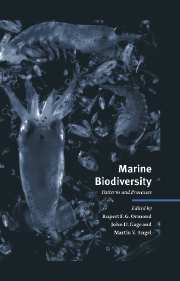Book contents
- Frontmatter
- Contents
- List of contributors
- Foreword: The value of diversity
- 1 Marine biodiversity in its global context
- 2 Gradients in marine biodiversity
- 3 Pelagic biodiversity
- 4 Biological diversity in oceanic macrozooplankton: More than counting species
- 5 Large-scale patterns of species diversity in the deep-sea benthos
- 6 Diversity, latitude and time: Patterns in the shallow sea
- 7 High benthic species diversity in deep-sea sediments: The importance of hydrodynamics
- 8 Diversity and structure of tropical Indo-Pacific benthic communities: Relation to regimes of nutrient input
- 9 Why are coral reef communities so diverse?
- 10 The biodiversity of coral reef fishes
- 11 The historical component of marine taxonomic diversity gradients
- 12 Population genetics and demography of marine species
- 13 Discovering unrecognised diversity among marine molluscs
- 14 Ecosystem function at low biodiversity – the Baltic example
- 15 Land–seascape diversity of the USA East Coast coastal zone with particular reference to estuaries
- 16 The development of mariculture and its implications for biodiversity
- 17 Protecting marine biodiversity and integrated coastal zone management
- 18 Conserving biodiversity in North-East Atlantic marine ecosystems
- Author index
- Species index
- Subject index
9 - Why are coral reef communities so diverse?
Published online by Cambridge University Press: 04 August 2010
- Frontmatter
- Contents
- List of contributors
- Foreword: The value of diversity
- 1 Marine biodiversity in its global context
- 2 Gradients in marine biodiversity
- 3 Pelagic biodiversity
- 4 Biological diversity in oceanic macrozooplankton: More than counting species
- 5 Large-scale patterns of species diversity in the deep-sea benthos
- 6 Diversity, latitude and time: Patterns in the shallow sea
- 7 High benthic species diversity in deep-sea sediments: The importance of hydrodynamics
- 8 Diversity and structure of tropical Indo-Pacific benthic communities: Relation to regimes of nutrient input
- 9 Why are coral reef communities so diverse?
- 10 The biodiversity of coral reef fishes
- 11 The historical component of marine taxonomic diversity gradients
- 12 Population genetics and demography of marine species
- 13 Discovering unrecognised diversity among marine molluscs
- 14 Ecosystem function at low biodiversity – the Baltic example
- 15 Land–seascape diversity of the USA East Coast coastal zone with particular reference to estuaries
- 16 The development of mariculture and its implications for biodiversity
- 17 Protecting marine biodiversity and integrated coastal zone management
- 18 Conserving biodiversity in North-East Atlantic marine ecosystems
- Author index
- Species index
- Subject index
Summary
Abstract
Extrinsic and intrinsic factors, physical and biological factors, and the interactions of all these are hypothesised to affect the diversity of coral reef-associated faunas. Extrinsic factors include environmental change at large spatial (regional) and temporal (geological) scales, and small (local or landscape) scale variation over ecologically relevant time. The latter also impinge on aspects intrinsic to the organisms, e.g. ecological specialisation, key innovations and life-history attributes, especially larval biology of sedentary benthic invertebrates. Certain species-rich genera and families of invertebrates and fishes contribute importantly to high species diversity of Indo-Pacific coral reefs. Naturally occurring gradients in diversity, ecology and life-history within these taxa can serve as dependent variables to test hypotheses of diversification. Gradient analyses of the most diverse genus of Indo-Pacific reef invertebrates, the gastropod Conus, support the ecological determinism and life-history hypotheses of diversity. The data do not refute other hypothesised mechanisms, which probably also operate. Broader application of gradient analysis to diverse taxa in the future may sharpen understanding of processes leading to modern patterns of diversity.
Introduction
Although geographically restricted to tropical seas and occupying only 0.1% of the earth's surface, coral reefs have globally important implications for marine biodiversity. Reefs support unusually diverse animal communities with distinctive taxonomic structure and geographical distribution patterns. Coral reefs are oases of high primary productivity in barren tropical seas, and reef-building organisms have changed the face of the earth by creating entire archipelagoes of islands and, over geological time, landforms that have become incorporated in continents.
- Type
- Chapter
- Information
- Marine BiodiversityPatterns and Processes, pp. 201 - 215Publisher: Cambridge University PressPrint publication year: 1997
- 10
- Cited by



